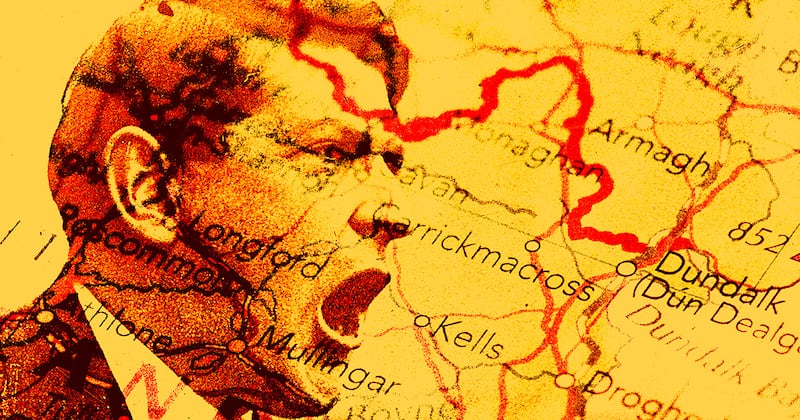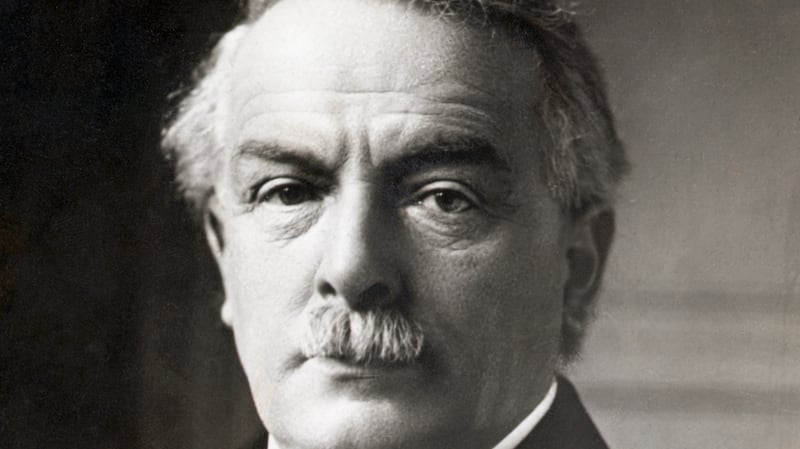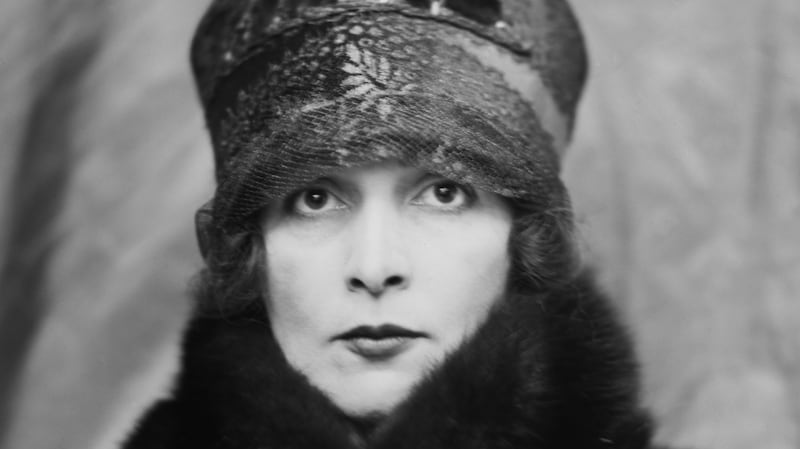On the evening of December 5th, 1921, after two months locked in negotiations with the Irish, the British prime minister David Lloyd George decided the end had come.
He stood up, and took two envelopes from his pocket. In one, he said, was the draft treaty the British were proposing the Irish should sign; in the other was a note saying the Irish had rejected the terms. The following day the new session of the Northern Irish parliament at Stormont was due to open. Lloyd George had promised the North's prime minister James Craig that he would report the result of the negotiations to him in time for the opening.
A special train was waiting "with steam up" at Euston Station, Lloyd George told the Irish; the train was to meet a destroyer at Holyhead which would carry the chosen letter to Craig in Belfast. To meet his deadline Lloyd George needed the Irish to sign or reject the treaty by 10pm. If the Irish rejected, he said, it would be war, "and war within three days!"

The Irish were outraged – "Michael Collins rose looking as though he was going to shoot someone", Winston Churchill later recalled – but they left to consider the ultimatum.
Lloyd George was known as the Welsh Wizard. One of the Irish delegates, George Gavan Duffy, described him as the "arch-trickster of the universe".
A trade unionist once asked advice from a colleague on how to deal with Lloyd George in person. “Better write to him,” he was told: “A letter after all cannot be mesmerised.”
That Lloyd George mesmerised the Irish seems clear from the facts that his timing was contrived and his threat was overstated, if not quite empty. The opening of the Stormont parliament was an arbitrary deadline. In fact, the deadline was missed: the destroyer arrived too late for Craig’s address to parliament; and when Craig reported back to parliament the following day, he said there was no urgency in responding to London.

Military threat
As for the military threat, Lloyd George had discussed the option of returning to war with his colleagues at various stages during the negotiations. He was told he would need 100,000 extra men in Ireland, which would take months to mobilise. This was despite him having promised the Irish weeks before that he would resign rather than oversee a renewed military campaign in Ireland.
Just two days previously the Irish delegation had attended an exhausting, recriminatory, inconclusive cabinet meeting in Dublin, at which they had agreed to reject the British terms, make a fresh attempt at a deal, and bring any new terms back to Dublin for discussion.
But now that they had a gun to their head. No one thought to insist on their right to consult with Dublin, and no one apparently thought to use the telephone. (Communication with Dublin throughout had been via courier for security reasons.)
The Irish had sought to deliver on the promise of 1916 of an all-island republic, while acknowledging the possibility that part of Ulster might retain a subsidiary parliament. De Valera’s “external association” scheme was intended to offer the compromise of close association with, but not within, the British empire.
But the British remained steadfast on those two issues: they would not tolerate an independent Ireland outside of the empire, and, though they had hoped that Craig would willingly lead his people into a united Ireland (likely with a federal or confederal structure), they had promised not to coerce him.
Arthur Griffith, the delegation chairman, was no republican purist: he had previously championed the model of "dual monarchy" whereby both Britain and Ireland, independently, could owe allegiance to the same king.
The British had expected Michael Collins to be a hardliner, and his brusque and undiplomatic manner had led them to underestimate him at first. But Collins knew the Irish army was exhausted – they had one gun per man, and less than one cartridge per gun – and believed compromise was inescapable.
Private meeting
That final morning Collins had had a private meeting with Lloyd George at which he secured further concessions on the oath (in line with a draft approved by the Supreme Council of the Irish Republican Brotherhood, of which Collins was president) and private assurances that a boundary commission would deliver “essential unity” by returning large swathes of Ulster to the south.
Collins quickly followed Griffith in agreeing to sign. One by one the others fell in. The last to hold out was Robert Barton. "You will be hanged from a lamp post in the streets of Dublin if your refusal to sign causes a new war in Ireland," Eamonn Duggan told him.
The negotiations were a story of trust forged and trust broken. The Treaty was built on the trust that grew, cautiously, between Griffith and Collins and, across the table, Lloyd George and Churchill in particular, even as trust within the Irish delegation broke down.
Collins was distrustful of de Valera’s professed reason for not leading the delegation: that he should keep himself in reserve, in a kind of good cop-bad cop strategy. Collins believed de Valera knew compromise on the Republic was inevitable and needed Collins to be a scapegoat for it.
De Valera didn't trust Griffith's moderate instincts or Collins' clandestine manoeuvres with the IRB; he sent Erskine Childers as secretary to the delegation specifically to keep an eye on them.
Childers was possibly the most intriguing character of all those around the table in London. Of Anglo-Irish stock and English upbringing, he had been a diligent servant of empire, seeing active service in the Boer War and Great War, as well as writing a wildly popular spy novel, The Riddle of the Sands.
But his Irish sympathies had grown to the point where he became a hardline republican. When Childers attended a meeting in Downing Street to discuss protocol for the negotiations, his opposite number, the British cabinet secretary, Maurice Hankey, was someone he had last seen on a boat at Gallipoli. Neither side trusted him.
Seeing Childers as an obstacle in the negotiations, Griffith and Collins sent word secretly to the British that they should propose a “sub-conference” to take place between the delegation leaderships, without need for secretaries. Thereafter, Griffith and Collins conducted the negotiations largely on their own.
The leading secretary on the British side was a Welshman Tom Jones, whose Whitehall Diaries, published posthumously in the 1960s and 1970s, are an extraordinarily rich source on the negotiations. (Frank Pakenham's Peace by Ordeal, a gripping, journalistic account, published in 1935, is another key source.) Jones was Lloyd George's sherpa, regularly arriving at the Irish quarters late at night to repair relations after a breakdown or alleviate some upcoming point of tension; he would speak Welsh with Lloyd George if they feared being overheard.
Jones played a critical role in massaging the Ulster issue. The Irish strategy, as it evolved, was to win back the Catholic-majority territories in the short term, and convince unionists in the long term that their economic interests lay in cooperation with Dublin. Griffith and Collins suggested having some kind of border poll to determine the area of Northern Ireland, but were persuaded, by Jones first, and then by Lloyd George and Churchill, that a boundary commission would achieve the same ends.
Elusive role
Playing a similarly elusive role was Hazel Lavery, a renowned Irish-American society hostess married to the Irish painter John Lavery (he painted portraits of all the delegates during the negotiations. Collins insisted on facing the door as he sat for his portrait, Lavery recalled.)
Collins was writing regularly to his fiancee Kitty Kiernan throughout, but Hazel Lavery's friends believed, and Lavery implied, that she and Collins became lovers. (Lavery's biographer, Sinéad McCoole, notes that she was "notoriously unreliable" on such matters.)

Her own and her husband’s accounts claimed she was a decisive influence in persuading Collins to accept the terms of the treaty; she was reported to have driven Collins to Downing Street for his final meeting with Lloyd George, though these accounts conflict with other sources.
Elsewhere, as is typical of the politics (and the historiography) of the time, the women remained off-stage. Lloyd George had a 30-year affair with his personal secretary Frances Stevenson, whom he married after his wife died. Her diaries and their letters reveal her to have been a key political confidante, but they are silent for this period, perhaps because Lloyd George was so consumed with the Irish negotiations.
Kathleen McKenna, a 24-year-old member of the secretarial pool for the Irish delegation, later wrote a vivid memoir, A Dáil Girl’s Revolutionary Recollections. She recalled Collins pacing up and down the hallway in Hans Place on that crucial night “like a wild beast in a cage” as he waited for the others to make their decision. McKenna had been doing underground work for the Dáil’s propaganda services since 1919. The State would later repeatedly refuse her applications for a military service medal and pension.
Inspiration
In 2016 I had a play about the Easter Rising, Inside the GPO, staged by the theatre company Fishamble in the GPO. Pauric Dempsey of the Royal Irish Academy alerted me to the existence of the Tom Jones diaries, and they became the inspiration for a play set inside the Treaty negotiations.
For much of 2018-2019 I felt I was writing a play about Brexit. A small island nation attempting to remove itself from one of the world’s most influential trading blocks. A British government hemmed in by Tory diehards on its back benches. Debate over customs areas and free trade agreements. The key question: would this new border be on the island or in the Irish Sea?
There was even a "Canada plus" option – London was offering Dublin the option of Canada-style Dominion status plus added guarantees. It was intriguing to find the resonances between the Irish republicanism of a century ago and the Brexiteers of today.
History plays are never just about the history: they are always also about the present. The immediate salience of Brexit may have receded, but now it is the arguments in the play about the Border in particular that seem to reach out across time.
Collins, unsurprisingly, emerges as the key character, desperately trying to end one war without precipitating another. He brought charisma and sometimes comedy to the negotiations, such as the time, recorded by T Ryle Dwyer, that he interrupted a bombastic Churchillian tirade by slamming his fist on the table, crying, "for Christ's sake, come to the point!" Churchill was stunned; Collins erupted in laughter; and then Churchill joined in.
Did Lloyd George mesmerise Collins, or did Collins silently acquiesce to Lloyd George’s pressure tactics, knowing it was the only way a necessary treaty would get signed?
The study of history will never provide a definitive answer; but drama allows us imagine one.
The Treaty by Colin Murphy will be staged by Fishamble: the New Play Company at the National Concert Hall in November/December, details to be confirmed. For updates subscribe to Fishamble's email newsletter at www.fishamble.com or follow @colinmurphyinfo or @fishamble on Twitter.



















